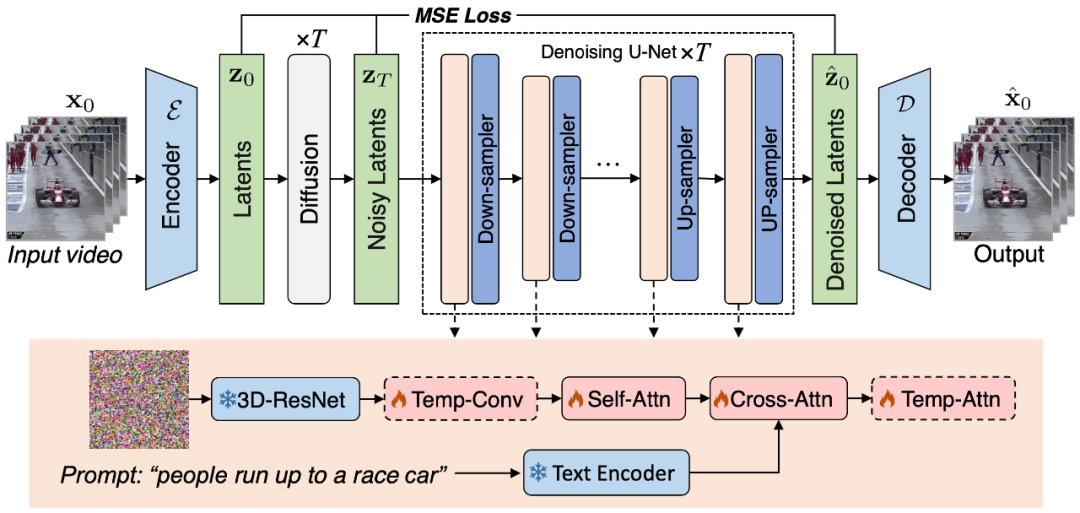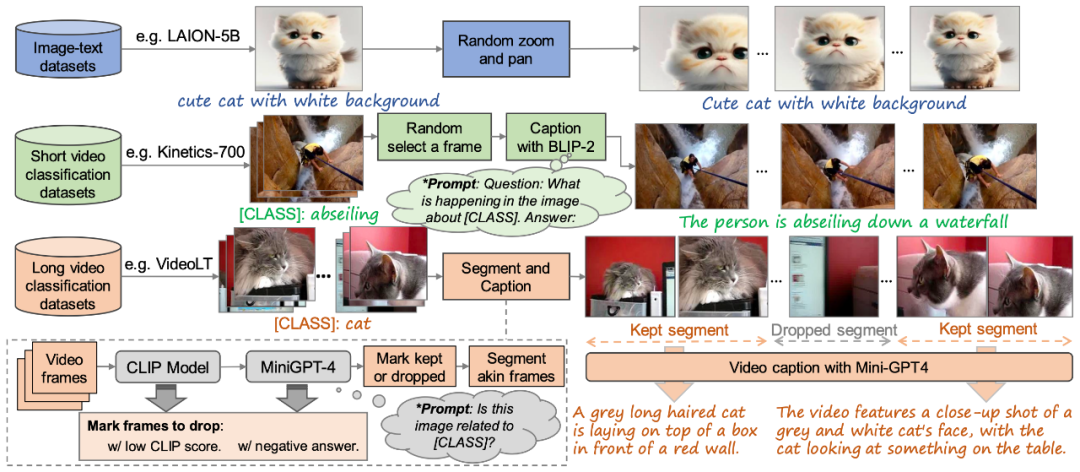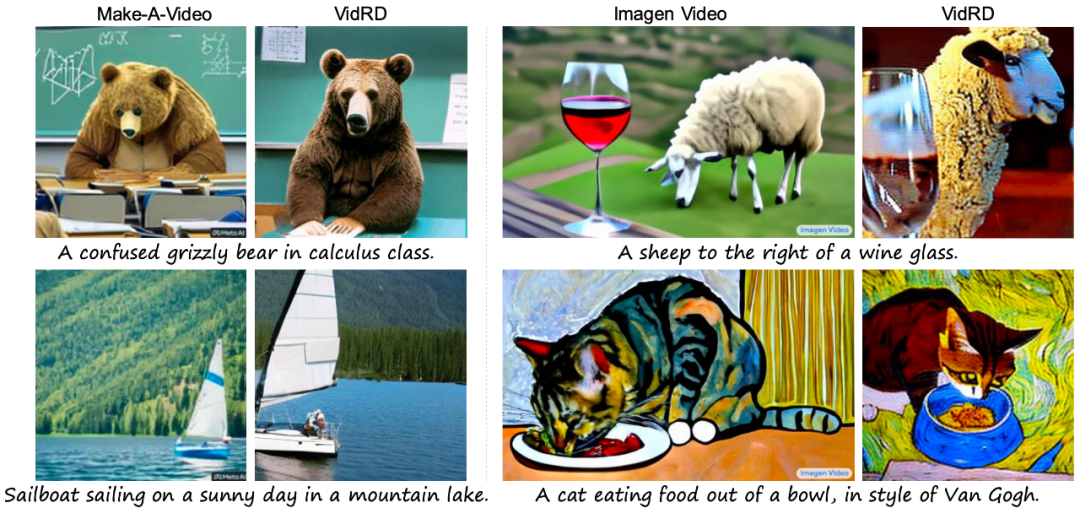 Technology peripherals
Technology peripherals
 AI
AI
 Fudan University and Huawei Noah propose the VidRD framework to achieve iterative high-quality video generation
Fudan University and Huawei Noah propose the VidRD framework to achieve iterative high-quality video generation
Fudan University and Huawei Noah propose the VidRD framework to achieve iterative high-quality video generation
Researchers from Fudan University and Huawei's Noah's Ark Laboratory proposed an iterative solution for generating high-quality videos based on the image diffusion model (LDM) - VidRD (Reuse and Diffuse). This solution aims to make breakthroughs in the quality and sequence length of generated videos, and achieve high-quality, controllable video generation of long sequences. It effectively reduces the jitter problem between generated video frames, has high research and practical value, and contributes to the current hot AIGC community.
Latent diffusion model (LDM) is a generative model based on denoising autoencoder, which can generate high-quality data from randomly initialized data by gradually removing noise. sample. However, due to computational and memory limitations during both model training and inference, a single LDM can usually only generate a very limited number of video frames. Although existing work attempts to use a separate prediction model to generate more video frames, this also incurs additional training costs and produces frame-level jitter.
In this paper, inspired by the remarkable success of latent diffusion models (LDMs) in image synthesis, a framework called "Reuse and Diffuse", referred to as VidRD, is proposed. This framework can generate more video frames after the small number of video frames already generated by LDM, thereby iteratively generating longer, higher quality, and diverse video content. VidRD loads a pre-trained image LDM model for efficient training and uses a U-Net network with added temporal information for noise removal.

- ##Paper title: Reuse and Diffuse: Iterative Denoising for Text-to-Video Generation
- Paper address: https://arxiv.org/abs/2309.03549
- Project homepage: https://anonymous0x233.github.io/ ReuseAndDiffuse/
The main contributions of this article are as follows:
- In order to generate smoother videos, this article is based on timing-aware The LDM model proposes an iterative "text-to-video" generation method. This method can iteratively generate more video frames by reusing latent space features from already generated video frames and following the previous diffusion process each time.
- This article designs a set of data processing methods to generate high-quality "text-video" data sets. For the existing action recognition data set, this paper uses a multi-modal large language model to give text descriptions to the videos. For image data, this paper uses random scaling and translation methods to generate more video training samples.
- On the UCF-101 data set, this article verified the two evaluation indicators of FVD and IS as well as the visualization results. The quantitative and qualitative results show that: compared with existing methods, the VidRD model All achieved better results.
Method introduction

Figure 1. Schematic diagram of the VidRD video generation framework proposed in this article
This article believes that using pre-trained image LDM as the starting point for LDM training for high-quality video synthesis is an efficient and wise choice. At the same time, this view is further supported by research work such as [1, 2]. In this context, the carefully designed model in this article is built based on the pre-trained stable diffusion model, fully learning from and inheriting its excellent characteristics. These include a variational autoencoder (VAE) for accurate latent representation and a powerful denoising network U-Net. Figure 1 shows the overall architecture of the model in a clear and intuitive way.
In the model design of this article, a notable feature is the full utilization of the weights of the pre-trained model. Specifically, most network layers, including the components of VAE and the upsampling and downsampling layers of U-Net, are initialized using pre-trained weights of the stable diffusion model. This strategy not only significantly speeds up the model training process, but also ensures that the model exhibits good stability and reliability from the beginning. Our model can iteratively generate additional frames from an initial video clip containing a small number of frames by reusing the original latent features and mimicking the previous diffusion process. In addition, for the autoencoder used to convert between pixel space and latent space, we inject timing-related network layers into its decoder and fine-tune these layers to improve temporal consistency.
In order to ensure the continuity between video frames, this article adds 3D Temp-conv and Temp-attn layers to the model. The Temp-conv layer follows the 3D ResNet, which implements 3D convolution operations to capture spatial and temporal correlations to understand the dynamics and continuity of video sequence aggregation. The Temp-Attn structure is similar to Self-attention and is used to analyze and understand the relationship between frames in the video sequence, allowing the model to accurately synchronize the running information between frames. These parameters are randomly initialized during training and are designed to provide the model with understanding and encoding of temporal structure. In addition, in order to adapt to the model structure, the data input has also been adapted and adjusted accordingly.

Figure 2. The high-quality “text-video” training data set construction method proposed in this article
In order to train the VidRD model, this article proposes a method of constructing a large-scale "text-video" training data set, as shown in Figure 2. This method can handle "text-image" data and "text-video" without description data. In addition, in order to achieve high-quality video generation, this article also attempts to remove watermarks on the training data.
Although high-quality video description datasets are relatively scarce in the current market, a large number of video classification datasets exist. These datasets have rich video content, and each video is accompanied by a classification label. For example, Moments-In-Time, Kinetics-700 and VideoLT are three representative large-scale video classification data sets. Kinetics-700 covers 700 human action categories and contains over 600,000 video clips. Moments-In-Time includes 339 action categories, with a total of more than one million video clips. VideoLT, on the other hand, contains 1,004 categories and 250,000 long, unedited videos.
In order to make full use of existing video data, this article attempts to automatically annotate these videos in more detail. This article uses multi-modal large language models such as BLIP-2 and MiniGPT4. By targeting key frames in the video and combining their original classification labels, this article designs many Prompts to generate annotations through model question and answer. This method not only enhances the speech information of video data, but also brings more comprehensive and detailed video descriptions to existing videos that do not have detailed descriptions, thereby enabling richer video tag generation to help the VidRD model bring better training effect.
In addition, for the existing very rich image data, this article also designed a detailed method to convert the image data into video format for training. The specific operation is to pan and zoom at different positions of the image at different speeds, thereby giving each image a unique dynamic presentation form and simulating the effect of moving a camera to capture still objects in real life. Through this method, existing image data can be effectively utilized for video training.
Effect display
The description texts are: "Timelapse at the snow land with aurora in the sky.", "A candle is burning .", "An epic tornado attacking above a glowing city at night.", and "Aerial view of a white sandy beach on the shores of a beautiful sea." More visualizations can be found on the project homepage.

Figure 3. Visual comparison of the generation effect with existing methods
Finally, as shown in Figure 3 shows the visual comparison of the generated results of this article with the existing methods Make-A-Video [3] and Imagen Video [4] respectively, showing the better quality generation effect of the model in this article.
The above is the detailed content of Fudan University and Huawei Noah propose the VidRD framework to achieve iterative high-quality video generation. For more information, please follow other related articles on the PHP Chinese website!

Hot AI Tools

Undresser.AI Undress
AI-powered app for creating realistic nude photos

AI Clothes Remover
Online AI tool for removing clothes from photos.

Undress AI Tool
Undress images for free

Clothoff.io
AI clothes remover

AI Hentai Generator
Generate AI Hentai for free.

Hot Article

Hot Tools

Notepad++7.3.1
Easy-to-use and free code editor

SublimeText3 Chinese version
Chinese version, very easy to use

Zend Studio 13.0.1
Powerful PHP integrated development environment

Dreamweaver CS6
Visual web development tools

SublimeText3 Mac version
God-level code editing software (SublimeText3)

Hot Topics
 Use ddrescue to recover data on Linux
Mar 20, 2024 pm 01:37 PM
Use ddrescue to recover data on Linux
Mar 20, 2024 pm 01:37 PM
DDREASE is a tool for recovering data from file or block devices such as hard drives, SSDs, RAM disks, CDs, DVDs and USB storage devices. It copies data from one block device to another, leaving corrupted data blocks behind and moving only good data blocks. ddreasue is a powerful recovery tool that is fully automated as it does not require any interference during recovery operations. Additionally, thanks to the ddasue map file, it can be stopped and resumed at any time. Other key features of DDREASE are as follows: It does not overwrite recovered data but fills the gaps in case of iterative recovery. However, it can be truncated if the tool is instructed to do so explicitly. Recover data from multiple files or blocks to a single
 Open source! Beyond ZoeDepth! DepthFM: Fast and accurate monocular depth estimation!
Apr 03, 2024 pm 12:04 PM
Open source! Beyond ZoeDepth! DepthFM: Fast and accurate monocular depth estimation!
Apr 03, 2024 pm 12:04 PM
0.What does this article do? We propose DepthFM: a versatile and fast state-of-the-art generative monocular depth estimation model. In addition to traditional depth estimation tasks, DepthFM also demonstrates state-of-the-art capabilities in downstream tasks such as depth inpainting. DepthFM is efficient and can synthesize depth maps within a few inference steps. Let’s read about this work together ~ 1. Paper information title: DepthFM: FastMonocularDepthEstimationwithFlowMatching Author: MingGui, JohannesS.Fischer, UlrichPrestel, PingchuanMa, Dmytr
 Hello, electric Atlas! Boston Dynamics robot comes back to life, 180-degree weird moves scare Musk
Apr 18, 2024 pm 07:58 PM
Hello, electric Atlas! Boston Dynamics robot comes back to life, 180-degree weird moves scare Musk
Apr 18, 2024 pm 07:58 PM
Boston Dynamics Atlas officially enters the era of electric robots! Yesterday, the hydraulic Atlas just "tearfully" withdrew from the stage of history. Today, Boston Dynamics announced that the electric Atlas is on the job. It seems that in the field of commercial humanoid robots, Boston Dynamics is determined to compete with Tesla. After the new video was released, it had already been viewed by more than one million people in just ten hours. The old people leave and new roles appear. This is a historical necessity. There is no doubt that this year is the explosive year of humanoid robots. Netizens commented: The advancement of robots has made this year's opening ceremony look like a human, and the degree of freedom is far greater than that of humans. But is this really not a horror movie? At the beginning of the video, Atlas is lying calmly on the ground, seemingly on his back. What follows is jaw-dropping
 Google is ecstatic: JAX performance surpasses Pytorch and TensorFlow! It may become the fastest choice for GPU inference training
Apr 01, 2024 pm 07:46 PM
Google is ecstatic: JAX performance surpasses Pytorch and TensorFlow! It may become the fastest choice for GPU inference training
Apr 01, 2024 pm 07:46 PM
The performance of JAX, promoted by Google, has surpassed that of Pytorch and TensorFlow in recent benchmark tests, ranking first in 7 indicators. And the test was not done on the TPU with the best JAX performance. Although among developers, Pytorch is still more popular than Tensorflow. But in the future, perhaps more large models will be trained and run based on the JAX platform. Models Recently, the Keras team benchmarked three backends (TensorFlow, JAX, PyTorch) with the native PyTorch implementation and Keras2 with TensorFlow. First, they select a set of mainstream
 The vitality of super intelligence awakens! But with the arrival of self-updating AI, mothers no longer have to worry about data bottlenecks
Apr 29, 2024 pm 06:55 PM
The vitality of super intelligence awakens! But with the arrival of self-updating AI, mothers no longer have to worry about data bottlenecks
Apr 29, 2024 pm 06:55 PM
I cry to death. The world is madly building big models. The data on the Internet is not enough. It is not enough at all. The training model looks like "The Hunger Games", and AI researchers around the world are worrying about how to feed these data voracious eaters. This problem is particularly prominent in multi-modal tasks. At a time when nothing could be done, a start-up team from the Department of Renmin University of China used its own new model to become the first in China to make "model-generated data feed itself" a reality. Moreover, it is a two-pronged approach on the understanding side and the generation side. Both sides can generate high-quality, multi-modal new data and provide data feedback to the model itself. What is a model? Awaker 1.0, a large multi-modal model that just appeared on the Zhongguancun Forum. Who is the team? Sophon engine. Founded by Gao Yizhao, a doctoral student at Renmin University’s Hillhouse School of Artificial Intelligence.
 Slow Cellular Data Internet Speeds on iPhone: Fixes
May 03, 2024 pm 09:01 PM
Slow Cellular Data Internet Speeds on iPhone: Fixes
May 03, 2024 pm 09:01 PM
Facing lag, slow mobile data connection on iPhone? Typically, the strength of cellular internet on your phone depends on several factors such as region, cellular network type, roaming type, etc. There are some things you can do to get a faster, more reliable cellular Internet connection. Fix 1 – Force Restart iPhone Sometimes, force restarting your device just resets a lot of things, including the cellular connection. Step 1 – Just press the volume up key once and release. Next, press the Volume Down key and release it again. Step 2 – The next part of the process is to hold the button on the right side. Let the iPhone finish restarting. Enable cellular data and check network speed. Check again Fix 2 – Change data mode While 5G offers better network speeds, it works better when the signal is weaker
 Kuaishou version of Sora 'Ke Ling' is open for testing: generates over 120s video, understands physics better, and can accurately model complex movements
Jun 11, 2024 am 09:51 AM
Kuaishou version of Sora 'Ke Ling' is open for testing: generates over 120s video, understands physics better, and can accurately model complex movements
Jun 11, 2024 am 09:51 AM
What? Is Zootopia brought into reality by domestic AI? Exposed together with the video is a new large-scale domestic video generation model called "Keling". Sora uses a similar technical route and combines a number of self-developed technological innovations to produce videos that not only have large and reasonable movements, but also simulate the characteristics of the physical world and have strong conceptual combination capabilities and imagination. According to the data, Keling supports the generation of ultra-long videos of up to 2 minutes at 30fps, with resolutions up to 1080p, and supports multiple aspect ratios. Another important point is that Keling is not a demo or video result demonstration released by the laboratory, but a product-level application launched by Kuaishou, a leading player in the short video field. Moreover, the main focus is to be pragmatic, not to write blank checks, and to go online as soon as it is released. The large model of Ke Ling is already available in Kuaiying.
 The U.S. Air Force showcases its first AI fighter jet with high profile! The minister personally conducted the test drive without interfering during the whole process, and 100,000 lines of code were tested for 21 times.
May 07, 2024 pm 05:00 PM
The U.S. Air Force showcases its first AI fighter jet with high profile! The minister personally conducted the test drive without interfering during the whole process, and 100,000 lines of code were tested for 21 times.
May 07, 2024 pm 05:00 PM
Recently, the military circle has been overwhelmed by the news: US military fighter jets can now complete fully automatic air combat using AI. Yes, just recently, the US military’s AI fighter jet was made public for the first time and the mystery was unveiled. The full name of this fighter is the Variable Stability Simulator Test Aircraft (VISTA). It was personally flown by the Secretary of the US Air Force to simulate a one-on-one air battle. On May 2, U.S. Air Force Secretary Frank Kendall took off in an X-62AVISTA at Edwards Air Force Base. Note that during the one-hour flight, all flight actions were completed autonomously by AI! Kendall said - "For the past few decades, we have been thinking about the unlimited potential of autonomous air-to-air combat, but it has always seemed out of reach." However now,





